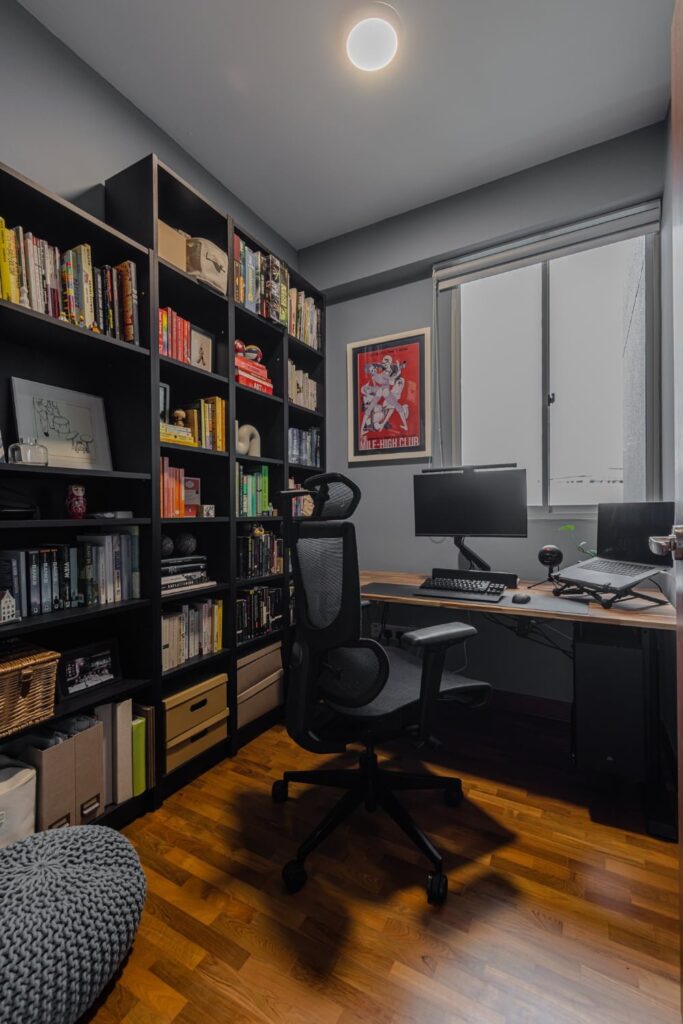Blog
Designing a Study Corner in a Shared Space
Creating a functional and comfortable study corner in a shared space can be a bit of a challenge, but with thoughtful planning, it’s definitely achievable. Whether you’re working from home in a shared living area, studying in a dorm room with roommates, or simply carving out a quiet nook in a busy household, designing a study corner that promotes productivity and focus is essential. Here are some tips to help you design an efficient and inspiring study corner, no matter how small the space.

1. Choose the Right Location
The first step in designing your study corner is choosing the right spot within the shared space. Ideally, you’ll want a place with minimal distractions but that still fits comfortably into the room.
- Find a quiet nook: Look for a corner or empty wall that is away from high-traffic areas in the room. If you’re in a shared living room or dining room, try setting up your study space along a wall or near a window to create a defined area.
- Natural light: If possible, set up your study corner near a source of natural light. Sunlight can help improve mood and productivity, so try to place your desk near a window if you can.
- Avoid distractions: Choose a spot where distractions, like TV or conversation areas, won’t interfere with your focus. If the room is busy, consider using a partition or screen to create separation.
2. Use a Compact, Multi-Functional Desk
In a shared space, you want to maximize the functionality of every piece of furniture. Opt for a small desk or writing table that can be tucked into a corner or against a wall. Look for designs that serve multiple purposes, offering storage or space for other items.
- Budget-friendly desk: A small desk with a simple design can easily be found at affordable prices. Consider desks with built-in shelves or drawers to reduce clutter and provide extra storage for school supplies, books, and papers.
- Foldable or wall-mounted desks: If you’re limited on space, a foldable desk or wall-mounted desk can be ideal. You can set it up when needed and fold it away when you’re finished, saving space for other activities in the room.
3. Maximize Vertical Space
When space is tight, thinking vertically can help you make the most of your study corner. Use shelves, wall hooks, or floating shelves to store books, stationery, and other study essentials without taking up valuable desk space.
- Wall-mounted shelves: Install shelves above your desk for books, study materials, or decorative items. This keeps your desk clutter-free and helps organize your space.
- Pegboards or hooks: A pegboard can help keep small items like pens, headphones, or notes organized. Use hooks for bags or accessories, keeping them off your desk but within easy reach.
4. Add Comfortable, Ergonomic Seating
If you’re going to be spending long hours in your study corner, comfort is key. Choose a chair that supports good posture while also fitting in with the style and size of the shared space.
- Ergonomic chair: A comfortable ergonomic chair will keep you supported while you study, but make sure it’s compact enough to fit into the corner. Adjustable chairs allow you to customize your seating position for comfort and support.
- Alternative seating: If space is limited, consider using a comfortable, padded chair or even a floor cushion with a backrest. If you need flexibility, consider a folding chair that you can tuck away when not in use.
5. Create Separation with Room Dividers
If you’re sharing a room with others, it can be helpful to create a sense of privacy. Room dividers or curtains are a great way to visually separate your study corner from the rest of the space, helping to minimize distractions and make the area feel more personal.
- Foldable screens or curtains: A foldable screen or a curtain mounted to the ceiling or on a tension rod can create a temporary barrier between your study corner and the rest of the room. This is especially helpful if you need to block out noise or create a more private, focused environment.
- Bookshelves as dividers: Use a tall bookshelf or a narrow storage unit as a physical barrier. This not only divides the space but also provides storage for your study materials.
6. Ensure Good Lighting
Lighting is essential for a productive study corner. A well-lit space helps reduce eye strain and creates a welcoming, energetic atmosphere for studying. Depending on the amount of natural light available, you’ll need to incorporate artificial lighting into your design.
- Desk lamps: A good-quality desk lamp with adjustable brightness can make all the difference when studying. Opt for a lamp that doesn’t take up too much space but provides enough light to keep you focused.
- Ambient lighting: In addition to your desk lamp, you can use soft ambient lighting in the room to create a cozy and warm atmosphere. String lights, floor lamps, or wall sconces are great options for filling the space with a soft glow that doesn’t distract from your work.
7. Incorporate Storage Solutions
A clutter-free study corner is essential for focus and productivity. Since you’re in a shared space, you’ll need to be strategic about storage. Consider using multifunctional furniture and organizing solutions to keep everything in its place.
- Storage baskets and bins: Use baskets, bins, or containers under your desk or on shelves to keep supplies like pens, notebooks, and paper organized. Labeling the containers can help you quickly find what you need.
- Under-desk organizers: Consider an under-desk storage unit or a rolling cart for additional supplies. These can be tucked away easily and pulled out when needed.
8. Personalize Your Study Corner
Adding a few personal touches can help make your study corner feel like your own space, even in a shared environment. A study space that feels cozy and inviting can boost motivation and productivity.
- Personalized décor: Decorate with items that inspire you, such as motivational quotes, a calendar, or framed photos. A few plants or decorative objects can also add personality and make your corner feel more comfortable.
- Color accents: Choose calming colors like soft blues, greens, or neutrals for your study area. These colors promote focus and calmness, which are essential for a productive study environment.
9. Use Noise-Cancelling Solutions
If you’re studying in a noisy environment, controlling noise can be challenging. Look for ways to reduce distractions so you can concentrate better.
- Noise-canceling headphones: Invest in a good pair of noise-canceling headphones or earbuds to block out distractions while you study. If you prefer background noise, listening to instrumental music or white noise can help you focus.
- Soft furnishings: Adding soft furnishings like rugs, cushions, or curtains can absorb sound and reduce the overall noise level in the room, helping create a quieter study corner.
10. Maintain Flexibility
Finally, make sure that your study corner is flexible enough to adapt to different needs. Shared spaces can change over time, so your setup should be easy to reconfigure if necessary.
- Adjustable furniture: Opt for furniture that can be easily rearranged or moved, like a rolling desk or chair. This allows you to quickly adapt your study corner as your needs change.
- Portable accessories: Keep essentials like notebooks, pens, or a laptop bag in a portable tote or organizer so you can move your study area around if needed.

Conclusion
Designing a study corner in a shared space requires a combination of creativity, practicality, and a little compromise. By choosing the right location, maximizing vertical space, incorporating functional storage, and adding personal touches, you can create a study area that promotes focus, productivity, and comfort. Whether you’re studying at home with roommates, in a family room, or in a dorm room, these tips will help you create a dedicated study space that works for you without disrupting the shared space. Keep your corner organized, comfortable, and inspiring, and you’ll have a productive and enjoyable study environment.


